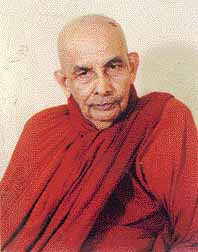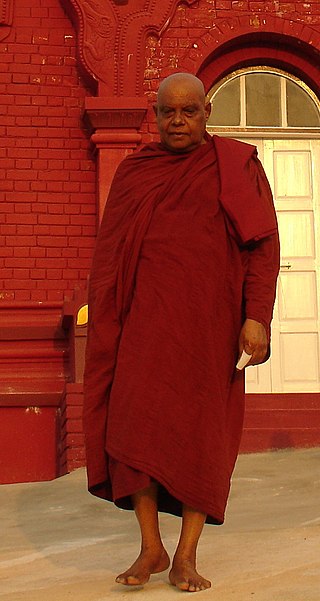Theravāda is the most commonly accepted name of Buddhism's oldest existing school. The school's adherents, termed Theravādins, have preserved their version of Gautama Buddha's teaching or Buddha Dhamma in the Pāli Canon for over two millennia.

A bhikkhu is an ordained male in Buddhist monasticism. Male and female monastics are members of the Sangha.

Mahāsī Sayādaw U Sobhana was a Burmese Theravada Buddhist monk and meditation master who had a significant impact on the teaching of vipassanā (insight) meditation in the West and throughout Asia.
In the Buddhist tradition, the five hindrances are identified as mental factors that hinder progress in meditation and in daily life. In the Theravada tradition, these factors are identified specifically as obstacles to the jhānas within meditation practice. Within the Mahayana tradition, the five hindrances are identified as obstacles to samatha (tranquility) meditation. Contemporary Insight Meditation teachers identify the five hindrances as obstacles to mindfulness meditation.
The Vipassanā movement, also called the Insight Meditation Movement and American Vipassana movement, refers to a branch of modern Burmese Theravāda Buddhism that promotes "bare insight" (sukha-Vipassana) to attain stream entry and preserve the Buddhist teachings, which gained widespread popularity since the 1950s, and to its western derivatives which have been popularised since the 1970s, giving rise to the more dhyana-oriented mindfulness movement.
The Buddhist Publication Society (BPS) is a publishing house with charitable status, whose objective is to disseminate the teachings of Gautama Buddha. It was founded in Kandy, Sri Lanka, in 1958 by two Sri Lankan lay Buddhists, A.S. Karunaratna and Richard Abeyasekera, and a European-born Buddhist monk, Nyanaponika Thera. Originally conceived as a limited effort to publish small, affordable books on fundamental Buddhist topics, the Society expanded in scope in response to the reception of their early publishing efforts. The Buddhist Publication Society's publications reflect the perspective of the Theravada denomination of Buddhism, drawing heavily from the Pāli Canon for source material.

Nyanaponika Thera or Nyanaponika Mahathera was a German-born Theravada Buddhist monk and scholar who, after ordaining in Sri Lanka, later became the co-founder of the Buddhist Publication Society and author of numerous seminal books and articles on Theravada Buddhism. He mentored and taught a whole generation of Western Buddhist leaders such as Bhikkhu Bodhi.

Ajahn is a Thai- and Lao-derived term that translates as "professor" or "teacher". The term is in turn derived from the Pali word ācariya and is a term of respect, similar in meaning to the Japanese sensei. It is used as a title of address for high school and university teachers, and for Buddhist monks who have passed ten vassa – in other words those who have maintained their monastic precepts unbroken for a period of ten years. The term Luang Por, "Venerable father", signifies an ajahn of acknowledged seniority in Thai Buddhism.
Most Ven. Matara Sri Nanarama Maha Thera was an influential Sri Lankan meditation master, scholar and forest monk of the 20th century.

Most Venerable Madihe Pannaseeha Mahathera was an eminent Sri Lankan Buddhist monk, who was the Mahanayaka of Amarapura sect from July 13, 1969, until his death on September 9, 2003.
The Nissarana Vanaya Meditation System was developed by Matara Sri Ñāṇārāma Mahathera, a highly respected senior meditation master of Sri Lanka and the first Upajjhaya of Sri Kalyani Yogasrama Samstha. This Buddhist meditation system uses samatha and vipassanā techniques in combination to allow what it claims are more intense insight results than ‘dry insight’ meditation. It was refined over decades by the head monks of the Nissarana Vanaya.
Aggamahāpaṇḍita is an honorific Burmese Buddhist title conferred by the Myanmar government to distinguished Theravada Buddhist monks.
Thero is an honorific term in Pali for senior bhikkhus and bhikkhunis in the Buddhist monastic order. The word literally means "elder". These terms, appearing at the end of a monastic's given name, are used to distinguish those who have at least 10 years since their upasampada. The name of an important collection of very early Buddhist poetry is called the Therigatha, "verses of the therīs".

Most Ven. Nauyane Ariyadhamma Maha Thera was a Sri Lankan bhikkhu and a senior meditation teacher. He was the spiritual advisor of the Sri Kalyani Yogasrama Samstha, and for many years resided at the Na Uyana Aranya. In 2011 he moved to Meetirigala Dharmayatanaya to help revitalize this long-standing place of learning and dhamma practice.
Samatha, "calm," "serenity," "tranquillity of awareness," and vipassanā, literally "special, super, seeing ", are two qualities of the mind developed in tandem in Buddhist practice.

Bhante Sujato, known as Ajahn Sujato or Bhikkhu Sujato, is an Australian Theravada Buddhist monk ordained into the Thai forest lineage of Ajahn Chah.
The history of Theravāda Buddhism begins in ancient India, where it was one of the early Buddhist schools which arose after the first schism of the Buddhist monastic community. After establishing itself in the Sri Lankan Anuradhapura Kingdom, Theravāda spread throughout mainland Southeast Asia through the efforts of missionary monks and Southeast Asian kings.










